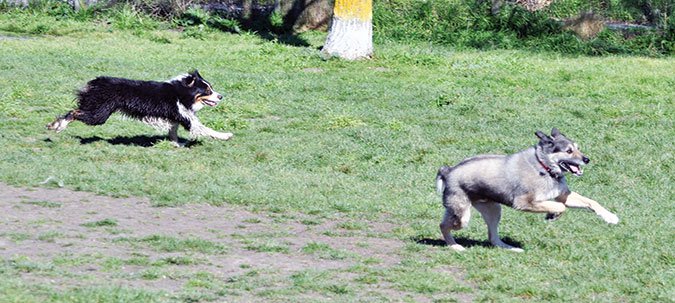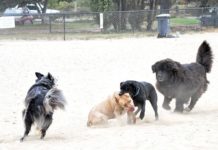
In recent years, more and more dog training and behavior professionals are speaking out against dog parks – yes, those safely fenced, community-funded spaces where dogs and their humans can get together and have a good time. What’s not to like?
If you ask almost any trainer, she will likely say, “Plenty!” As dog parks have become more common (and, indeed, as dog ownership has been on the rise in the past decade) they have somehow morphed from being something that local dog owners band together and fight to build, to places where few really knowledgeable owners care to take their dogs. It seems everyone has a horror story to tell about “that day at the dog park,” featuring overstimulated dogs running amok, dogs practicing bully behaviors, dog fights, and even dog deaths.
It’s true that all of those horrible things can happen at dog parks, but a lot of good things happen in dog parks, too, especially when they are well-constructed and well-managed, and when park users are smart about bringing appropriate dogs to the park and providing adequate supervision. Dog parks are a lifesaver for the owners of many dogs who need a little extra exercise and outdoor stimulation in order to be able to relax and behave well at home.
So do you take your dog to your local dog park or not? How do you know if you should? Or shouldn’t? Just as with so many other dog training and behavior questions, it depends!
7 Things to Consider About Dog Parks
There are a number of factors that determine whether a dog park is a good choice for your canine companion:
1. How your dog prefers to play.
Does your dog love to play with other dogs? Not all dogs do. Yes, they are a social species; that doesn’t mean they all get along. We humans are also a social species, and we certainly don’t get along with all humans!
If your dog is a confident, social butterfly, she might be a good dog park candidate. If she’s fearful around other dogs, she will be much happier not going to the park. (Consider, too, that her fear will likely deepen with every bad experience.) Some dogs are perfectly content with a small circle of intimate canine friends. Other dogs prefer the company of their human companions over any other canines. Bringing a dog who doesn’t enjoy the company of other dogs into an off-leash playground isn’t fair to your dog or any others who may approach her.
2. Your dog’s play style.
You need some awareness of what sort of play best suits your dog in order to gauge whether a particular park at a particular time of day is likely to provide her with an enjoyable play session or set her up to be traumatized (or traumatize others). Consider what your dog likes to do, and plan accordingly.
For example: Is your dog a fetchaholic? If her preference is to chase balls in a huge open space without being chased or pestered by any other dogs, bringing her to a cramped or crowded park might just set her up to snap at any unwary dog who gets in her way or tries to compete for the ball.
Consider the other typical dog park visitors, too. Does your dog love to play with other rowdy, rough-and-tumble brawlers at the park? That’s great if you can meet up with folks whose dogs enjoy that, too. But if your dog overwhelms other park visitors with his level of energy and arousal, it’s not fair to inflict your dog’s inappropriate play on them. Other dogs (and their owners) will not care that your dog is “just playing” if, while minding their own business, they get bowled over and hurt; they may respond with a dramatic protest and trigger an aggressive retort from the over-aroused roughhouser.
3. How much training your dog has.
To be fair to other park users, and in order to be able to keep your own dog safe, your dog should at least have a dynamite recall so you can call her back to you when you see trouble brewing. A full range of well-trained good manners behaviors is even better!
4. How your local dog park is constructed.
There are dog parks, and then there are dog parks. A well-constructed dog park is several acres or larger, solidly fenced, ideally with amenities that include water, equipment to play on, and varied terrain, such as open fields, creeks, and woods, so dogs have plenty to keep them environmentally engaged, rather than just pestering each other. Parks that are small, overcrowded and boring greatly increase the likelihood of inappropriate canine behavior (fights). Other important park features include separate areas for small and large dogs and double-gated entrances so dogs can’t escape as newcomers arrive.
5. How your local dog park is managed.
Every good dog park needs rules and someone to enforce them.Municipal parks, usually under the auspices of the parks and recreation department, may fall short on management. Rarely is there someone in attendance to deal with conflicts that may arise. City and county dog parks often compete with tennis courts, ball fields, playgrounds, and picnic areas for park staff attention.
Privately owned dog parks are more likely to have staff in attendance to assist in a timely manner with conflict resolution (canine and human) and enforcement of rules. Some parks require registration and issue numbered arm bands that owners must wear while in the park, for more effective reporting and investigation of problems.
6. The way your dog park is maintained.
Dog fights aren’t the only threat to your dog’s safety at a park. Poorly maintained fences and equipment can injure and kill dogs as easily as dog-dog altercations. Grass should be regularly mowed, and needed repairs promptly and routinely made. Make sure your park is getting its fair share of the park-maintenance budget!
7. Your local dog park culture.
This is the human side of things. If most owners are chatting with each other or on cell phones, rather than supervising their dogs’ activities, there are bound to be problems. If owners are oblivious to their dogs’ inappropriate behavior and allow mounting, bullying, and aggression to go uninterrupted, it’s not a healthy place for you and your dog to hang out.
Consider visiting the park on different days and at different times of the day; there may be knowledgeable and more engaged owners gathering at a different time.
- Dogs must be currently licensed. This ensures they are also current on rabies vaccination.
- No babies, toddlers, or small children allowed in the dog park. Communities may set different age limits, but 7 is a reasonable minimum age for children. Smaller, younger children are just too vulnerable to injury even from friendly dogs who get excited.
- Owners must pick up after their dogs. Always, no excuses, no exceptions. Good parks have well-maintained waste stations and keep poop-bag dispensers well-stocked.
- No dogs in season. Females in heat don’t belong in dog parks, ever.
- No aggressive dogs. Dog parks are not the appropriate place for owner to try to modify their dogs’ aggressive behavior. Dogs who have demonstrated aggression to dogs or humans should not be allowed to return to the park.
- Owners must be attentive to their dogs. Much inappropriate dog park behavior could be avoided if humans were paying attention and intervened before canine behavior escalated out of control.
- All gear, except for a collar with a quick-release buckle, should be removed from dogs before they enter the park. Harnesses, choke chains, pinch collars, and head halters pose special risks to the dogs wearing them and any dog who might become entangled in them while playing.
Check It Out
If you are confident that your dog is a good dog park candidate, ask some trusted, knowledgeable friends and your favorite canine professionals if they agree. If so, first visit parks in your area without your dog to check out the facilities and culture. Make several trips at various times so you get a real feel for the park and its users. If you like what you see after multiple visits, then you are ready to take your dog for playtime in the park.
Remember to supervise your dog responsibly while you are there, and always be ready to leave if you see things happening that make you or your dog uncomfortable.
DOG PARKS: OVERVIEW
1. Evaluate your dog carefully and honestly before taking her to a dog park.
2. Consider your dog-park choices thoroughly before taking your dog there.
3. Discuss the pros and cons of your area dog parks with your favorite local dog training and behavior professional(s).
4. Consider alternatives to dog parks, such as getting together with other dog owners in your area and creating compatible playgroups that meet in fenced backyards.





Should Dog Park grounds be treated to keep dos healthy?